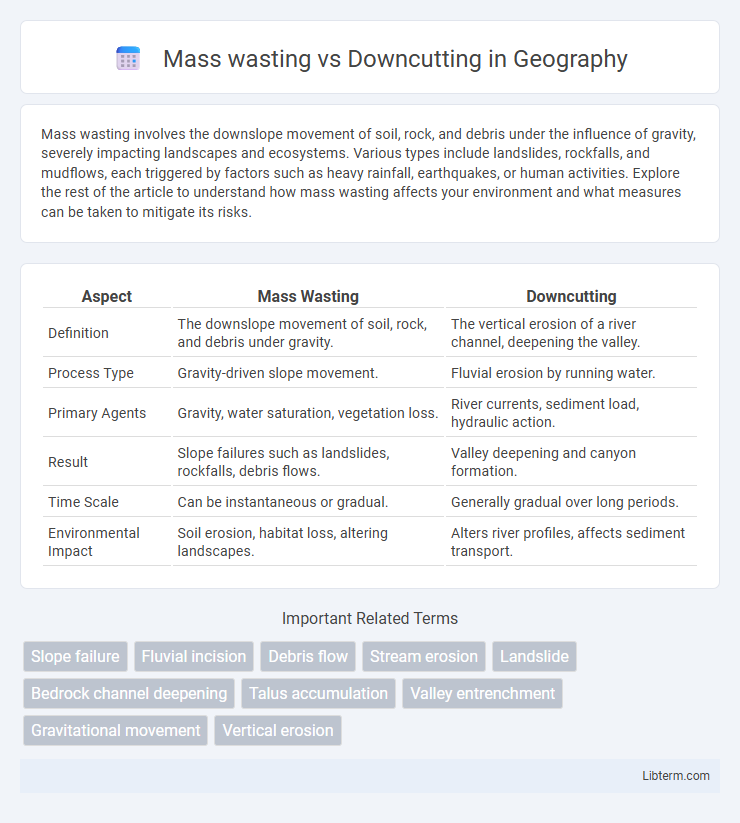Mass wasting involves the downslope movement of soil, rock, and debris under the influence of gravity, severely impacting landscapes and ecosystems. Various types include landslides, rockfalls, and mudflows, each triggered by factors such as heavy rainfall, earthquakes, or human activities. Explore the rest of the article to understand how mass wasting affects your environment and what measures can be taken to mitigate its risks.
Table of Comparison
| Aspect | Mass Wasting | Downcutting |
|---|---|---|
| Definition | The downslope movement of soil, rock, and debris under gravity. | The vertical erosion of a river channel, deepening the valley. |
| Process Type | Gravity-driven slope movement. | Fluvial erosion by running water. |
| Primary Agents | Gravity, water saturation, vegetation loss. | River currents, sediment load, hydraulic action. |
| Result | Slope failures such as landslides, rockfalls, debris flows. | Valley deepening and canyon formation. |
| Time Scale | Can be instantaneous or gradual. | Generally gradual over long periods. |
| Environmental Impact | Soil erosion, habitat loss, altering landscapes. | Alters river profiles, affects sediment transport. |
Introduction to Mass Wasting and Downcutting
Mass wasting involves the downslope movement of soil, rock, and debris due to gravity, playing a crucial role in shaping landscapes and influencing sediment transport. Downcutting refers to the vertical erosion by rivers and streams, deepening valleys and channel beds through the removal of substrate. Both processes significantly impact geomorphology, with mass wasting contributing to slope instability and downcutting driving river incision and landscape development.
Defining Mass Wasting
Mass wasting refers to the downslope movement of soil, rock, and debris under the influence of gravity, often triggered by factors such as water saturation, earthquakes, or slope angle. It contrasts with downcutting, which is the vertical erosion process by rivers that deepens valleys and channels. Understanding mass wasting is essential for assessing landslide risks and managing landscape stability.
Understanding Downcutting
Downcutting refers to the process where a river or stream erodes its bed vertically downward, deepening the channel and increasing stream gradient. This geological activity primarily occurs through hydraulic action, abrasion, and the removal of sediment, rapidly reshaping landscapes over time. Unlike mass wasting, which involves the downslope movement of soil and rock under gravity, downcutting directly influences river incision and valley formation.
Key Differences Between Mass Wasting and Downcutting
Mass wasting involves the downslope movement of soil and rock due to gravity, often triggered by factors like water saturation or seismic activity, whereas downcutting refers to the vertical erosion of a riverbed primarily caused by the river's kinetic energy cutting into the bedrock. Mass wasting results in sudden landslides or gradual creep, impacting slope stability, while downcutting shapes river valleys and influences sediment transport. Understanding these processes is essential for managing erosion hazards and landscape evolution in geomorphology.
Types and Forms of Mass Wasting
Mass wasting encompasses various types such as falls, slides, flows, and creep, each representing different movement speeds and material consistencies, including rockfalls, landslides, debris flows, and soil creep. These processes result in the downslope movement of soil, rock, and organic material under gravity, often triggered by factors like water saturation, earthquakes, or human activity. Downcutting, in contrast, specifically refers to vertical erosion by a river or stream, deepening the channel through the removal of bedrock and sediment, and is not classified within mass wasting types.
Processes Involved in Downcutting
Downcutting primarily involves vertical erosion where a river or stream deepens its channel by removing sediment and bedrock through hydraulic action, abrasion, and corrosion. This process is driven by the energy of flowing water, which dislodges and transports particles, enhancing the channel's depth over time. In contrast, mass wasting entails the downslope movement of soil and rock due to gravity, without the concentrated erosive force seen in downcutting.
Environmental Factors Influencing Mass Wasting
Environmental factors influencing mass wasting include heavy rainfall, which saturates soil and reduces its cohesion, increasing the likelihood of slope failure. Vegetation cover stabilizes slopes by binding soil with roots, so deforestation or wildfires dramatically raise mass wasting risks. Steep slopes, seismic activity, and human excavation also contribute to gravitational movement by altering slope stability and triggering landslides or debris flows.
Environmental Factors Influencing Downcutting
Environmental factors influencing downcutting include stream gradient, discharge, and sediment load, which collectively affect the river's erosive power and rate of bed incision. Vegetation cover and soil composition impact the stability of riverbanks, thereby modulating the downcutting process. Climatic conditions such as precipitation intensity and frequency also play a critical role in altering erosional dynamics and sediment transport during downcutting.
Real-World Examples: Mass Wasting vs Downcutting
Mass wasting events such as the 2018 Palmdale landslide in California demonstrate rapid downhill movement of soil and rock driven by gravity, causing significant landscape alteration and hazards. In contrast, downcutting processes are exemplified by the Colorado River carving the Grand Canyon, where sustained vertical erosion deepens river valleys over millions of years. Mass wasting reshapes slopes abruptly, whereas downcutting progressively incises channels, both critical in geomorphological evolution.
Conclusion: Impacts and Geological Significance
Mass wasting reshapes landscapes rapidly by moving large volumes of earth material downslope, significantly influencing slope stability and sediment distribution. Downcutting occurs through river erosion, deepening valleys and shaping bedrock profiles over geological time scales, thus controlling river morphology and sediment transport. Both processes are fundamentally interconnected in landscape evolution, driving geomorphological change and affecting ecosystems and human infrastructure.
Mass wasting Infographic

 libterm.com
libterm.com